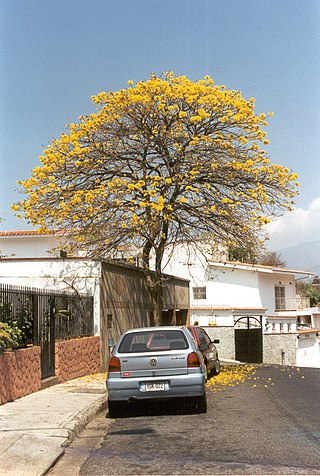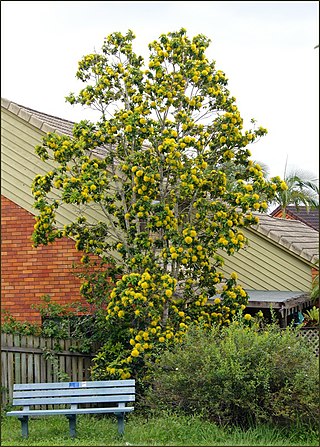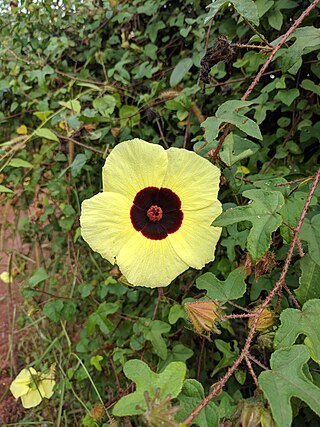
Hibiscus is a genus of flowering plants in the mallow family, Malvaceae. The genus is quite large, comprising several hundred species that are native to warm temperate, subtropical and tropical regions throughout the world. Member species are renowned for their large, showy flowers and those species are commonly known simply as "hibiscus", or less widely known as rose mallow. Other names include hardy hibiscus, rose of sharon, and tropical hibiscus.

Hibiscus syriacus is a species of flowering plant in the mallow family, Malvaceae. It is native to south-central and southeast China, but widely introduced elsewhere, including much of Asia, both in the east and the west. It was given the epithet syriacus because it had been collected from gardens in Syria. Common names include the rose of Sharon,, Syrian ketmia, shrub althea, and rose mallow. It is the national flower of South Korea and is mentioned in the South Korean national anthem.

Hibiscus rosa-sinensis, known colloquially as Chinese hibiscus, China rose, Hawaiian hibiscus, rose mallow and shoeblack plant, is a species of tropical hibiscus, a flowering plant in the Hibisceae tribe of the family Malvaceae. It is widely cultivated as an ornamental plant in the tropics and subtropics, but its native range is Vanuatu.

Fremontodendron, with the common names fremontia and flannelbush or flannel bush, is a genus of three known species of shrubs native to the Southwestern United States and northwest Mexico.

Thespesia populnea, commonly known as the portia tree, Pacific rosewood, Indian tulip tree, or milo, among other names, is a species of flowering plant belonging to the mallow family, Malvaceae. It is a tree found commonly on coasts around the world. Although it is confirmed to be native only to the Old World tropics, other authorities consider it to have a wider, possibly pantropical native distribution. It is thought to be an invasive species in Florida and Brazil.

Abelmoschus is a genus of about fifteen species of flowering plants in the mallow family (Malvaceae), native to tropical Africa, Asia and northern Australia. It was formerly included within Hibiscus, but is now classified as a distinct genus. The genus name derives from Arabic meaning 'father of musk' or 'source of musk' referring to the scented seeds.

Hibiscus trionum, commonly called flower-of-an-hour, bladder hibiscus, bladder ketmia, bladder weed, puarangi and venice mallow, is an annual plant native to the Old World tropics and subtropics. It has spread throughout southern Europe both as a weed and cultivated as a garden plant. It has been introduced to the United States as an ornamental where it has become naturalized as a weed of cropland and vacant land, particularly on disturbed ground.

Hibiscus waimeae is a species of flowering plant within the okra family, Malvaceae, that is endemic to the island of Kauaʻi in Hawaii.

Hibiscus clayi, common names red Kauai rosemallow, Clay's hibiscus or Kokiʻo ʻula, is a perennial angiosperm of the mallow family Malvaceae.

Thespesia grandiflora is a tree in the family Malvaceae of the rosids clade. Its common name is maga and sometimes is referred to as Maga Colorada and Puerto Rican hibiscus. This tree is widely distributed throughout Puerto Rico where it is endemic. Although originally endemic to the humid mountains of limestone in the western and north-central portions of the Island, today it grows everywhere in Puerto Rico due to its extensive cultivation. It is also grown as an ornamental tree in Florida, Hawaii, Honduras and in various Caribbean islands. The maga is mostly used as an ornamental plant, but like the related Thespesia populnea its wood is also valued for its durable timber. The flower was declared the national symbol of Puerto Rico on August 7, 2019.

Hibiscus moscheutos, the rose mallow, swamp rose-mallow, crimsoneyed rosemallow, or eastern rosemallow, is a species of flowering plant in the family Malvaceae. It is a cold-hardy perennial wetland plant that can grow in large colonies. The hirsute leaves are of variable morphology, but are commonly deltoidal in shape with up to three lobes. It is found in wetlands and along the riverine systems of the eastern United States from Texas to the Atlantic states, its territory extending northward to southern Ontario.

Hibiscadelphus distans is an extremely rare species of flowering plant in the mallow family, Malvaceae, that is endemic to the island of Kauaʻi in Hawaii. It is known as hau kuahiwi in Hawaiian, which means "upland Hibiscus tiliaceus." It is a bush or small tree with heart-shaped leaves and yellow flowers and grows at between 1,000 and 1,800 feet in the remnants of native dry forests. Despite its rarity, it is believed to be the only surviving species in the genus Hibiscadelphus which is only known from Hawaii, the other five species having recently become extinct in the wild, some being known from only a single plant.

Handroanthus chrysanthus, formerly classified as Tabebuia chrysantha, also known as araguaney in Venezuela, as guayacán in Colombia, as chonta quiru in Peru, Panama, and Ecuador, as tajibo in Bolivia, and as ipê-amarelo in Brazil, is a native tree of the intertropical broadleaf deciduous forests of South America above the Tropic of Capricorn. On May 29, 1948, Handroanthus chrysanthus was declared the National Tree of Venezuela due to its status as an emblematic native species of extraordinary beauty. Its deep yellow resembles that of the Venezuelan flag.

Xanthostemon chrysanthus, commonly known as golden penda, is a species of tree in the myrtle family Myrtaceae which is endemic to north eastern Queensland, Australia. It is a popular garden plant with showy yellow blooms, and is the floral emblem of the city of Cairns.

Zanthoxylum asiaticum is a species of plant in the family Rutaceae. Under its synonym Toddalia asiatica, it was the only species in the monotypic genus Toddalia, now included in Zanthoxylum. It is known by the English name orange climber.

Pavonia hastata, commonly known as spearleaf swampmallow or pink pavonia, is a shrub in the family Malvaceae. The species is native to Brazil, Bolivia, Argentina, Paraguay and Uruguay. It was previously considered to be native to Australia as well, but is no longer thought to be.

Balduina uniflora is a North American species of plants in the sunflower family. It is native to the southeastern United States. It is the type species of Genus Balduina.

Hibiscus aculeatus is a species of plant in the family Malvaceae. Common names include comfortroot and pineland hibiscus.

Hibiscus hamabo, the hardy yellow hibiscus, is a species of shrub in the genus Hibiscus that is native to the coastlines of China, Japan, and Korea. It is characterized by yellow flower coloring as well as orbicular shaped leaves. In its native environment it is a perennial.
Hibiscus paramutabilis, the everblooming Confederate rose, is a species of flowering plant in the family Malvaceae, native to southeastern China. A deciduous shrub reaching 1 to 4 m at maturity, in the wild it is found in scrubland, slopes, and valleys from 500 to 1,100 m above sea level. In the garden it is hardy to USDA zone 7a, and produces white, pink or rose‑pink flowers that are 15 to 30 cm wide, blooming from spring to early winter.




















